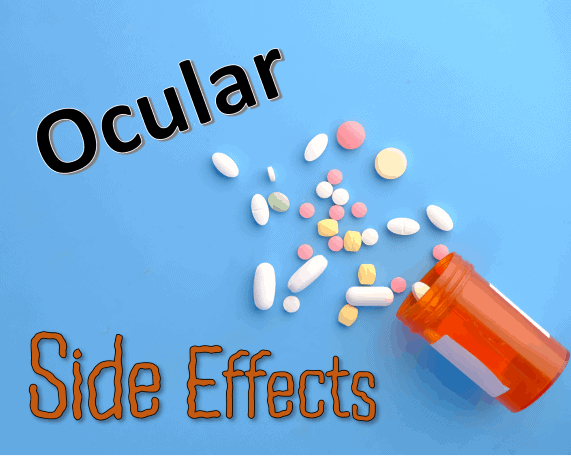
Ocular Side Effects of Common Medications
September 30, 2021


In general, medications that are part of an “anti-“ family, tend to cause or contribute to dry eyes. Antihistamines, antidepressants, and antihypertensives are a few examples of medications that can lead to dry eyes.
Steroids, whether administered topically to the eye or taken orally, can affect the eyes negatively in some circumstances. High doses and prolonged use of steroids can cause cataracts and glaucoma. Cataracts related to steroid-use usually have a quicker onset and progress faster than the typical age-related form of cataracts. Some people develop increased eye pressure while on steroids. Elevated eye pressure can lead to glaucoma and result in permanent vision loss.
More specifically, the following list includes some of the most commonly prescribed medications that can have associated ocular side effects.
Hydroxychloroquine (Plaquenil)
Plaquenil is used to treat autoimmune disorders, such as rheumatoid arthritis and lupus. Maculopathy, or changes to the macula (central area of the retina responsible for precise vision), is an ocular side effect that is monitored during the course of taking Plaquenil. The risk of maculopathy increases after taking the medication for more than 5 years. Therefore, it is important to have a baseline eye exam with a visual field test and macula scans at the start of taking Plaquenil. Future testing is compared back to the baseline to note any changes. The eye care provider and rheumatologist will work together to make sure the retina does not become affected while taking Plaquenil.
Topiramate (Topamax)
Topamax is typically used to treat migraine headaches, seizures, and mood disorders. Chronic pupil dilation can occur, which may lead to acute angle closure glaucoma. This type of glaucoma is seen when circulating fluid within the eye does not have an adequate place to drain, so the fluid builds up and greatly increases the eye pressure. Once the eye pressure is very high, the eyes become red and painful. When associated with Topamax use, acute angle closure glaucoma is typically present in both eyes.
Isotretinoin (Accutane)
Accutane is a medication used to treat acne. While its drying properties are helpful for treating acne, it can also make the skin, lips, and eyes dry too. The dryness can range from mild to severe, and some individuals are unable to tolerate contact lenses while taking the medication. Treating the dry eye syndrome with artificial tears is usually enough for most people. If the dryness is severe, light sensitivity and blurred vision may also occur. In rare cases, papilledema (optic nerve swelling) can occur and requires immediate discontinuation of the medication.
Tamoxifen (Nolvadex)
This medication is used in the long-term treatment of breast and ovarian cancer. It is typically used for 5 years or less. Tamoxifen can cause yellow, crystalline deposits in the macula area of the retina, which leads to blurred vision. Some individuals may also develop opacities in the cornea, which hinders vision as well. Once discontinuing the medication, vision changes associated with Tamoxifen typically resolve and do not cause lasting problems.
Tamsulosin (Flomax)
Flomax is a common treatment for benign prostatic hyperplasia (enlarged prostate) and associated urinary symptoms. Intraoperative floppy iris syndrome is a side effect of Flomax, which complicates cataract surgery. It is very important to tell the cataract surgeon of any previous use of Flomax prior to surgery. There is an increased risk of intraoperative floppy iris syndrome even after taking Flomax for a short period of time and stopping years prior to having cataract surgery.
Sildenafil (Viagra) & Tadalafil (Cialis)
Used to treat erectile dysfunction, both Viagra and Cialis can lead to ocular side effects when used at high doses. Blurry vision, light sensitivity, and cyanopsia (blue-tinted vision) are reversible vision changes that last several hours after taking the pill. More concerning, these medications can cause permanent vision loss by damaging the optic nerve through a condition called nonarteritic anterior ischemic optic neuropathy (NAION). Individuals who develop NAION usually have other predisposing ocular factors that contribute to this minimally prevalent side effect.
If you notice changes to your vision, schedule an appointment with your eye doctor, and be sure to disclose all medications you are taking. It is important to not discontinue medications on your own without first discussing with the prescribing physician.